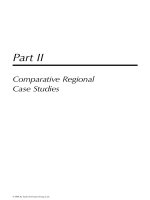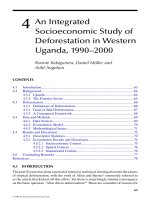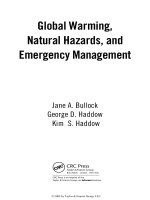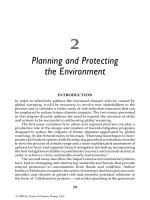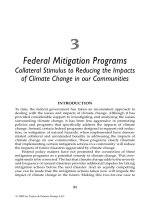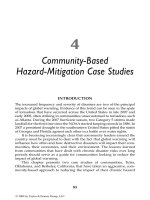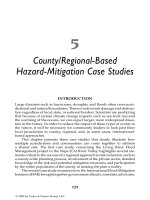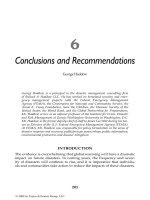Global Warming, Natural Hazards, and Emergency Management - Chapter 3 pot
Bạn đang xem bản rút gọn của tài liệu. Xem và tải ngay bản đầy đủ của tài liệu tại đây (1.27 MB, 32 trang )
51
3
Federal Mitigation Programs
Collateral Stimulus to Reducing the Impacts
of Climate Change in our Communities
IntroductIon
To date, the federal government has taken an inconsistent approach to
dealing with the issues and impacts of climate change. Although it has
provided considerable support to investigating and analyzing the issues
surrounding climate change, it has been less aggressive in promoting
policies and programs that specically address the impacts of climate
change. Instead, certain federal programs designed to support risk reduc-
tion, or mitigation of natural hazards, when implemented have demon-
strated collateral and unintended benets in addressing the impacts of
climate change on our communities. These programs clearly illustrate
that implementing certain mitigation actions in a community will reduce
the impacts of future disasters aggravated by climate change.
Federal policy makers have not promoted the connection of these
mitigation programs as a potential remedy to climate change. This over-
sight needs to be corrected. The fact that climate change adds to the severity
and frequency of natural disasters provides additional impetus for taking
mitigation actions before the next disaster. And an equally compelling
case can be made that the mitigation actions taken now will impede the
impact of climate change in the future. Making this two-for-one case to
© 2009 by Taylor & Francis Group, LLC
GLOBAL WARMING, NATURAL HAZARDS, AND EMERGENCY MANAGEMENT
52
community leaders makes economic sense and provides coverage for
community leaders that they are addressing the more immediate and
politically salient issue of climate change.
The intent of this chapter is to discuss several current and past
community-based federal mitigation programs administered by the
Federal Emergency Management Administration (FEMA), now a part of
the Department of Homeland Security (DHS) and their collateral inu-
ences on reducing the impact of climate change. The programs that will
be examined include the National Flood Insurance Program (NFIP), the
Property Acquisitions program, and Project Impact: Building a Disaster
Resistant Community.
In the case of the NFIP, we will explore the controversy surrounding
the costs and benets to communities of participating in the NFIP. The
NFIP has been described, on the one hand, as mitigating the future risks
from climate change through good oodplain management, and on the
other hand, as offering low-cost insurance, which fosters development in
coastal areas that exacerbates the impact of climate change.
the natIonal flood Insurance
Program (nfIP): helP or hIndrance
Jane Bullock
Jane A. Bullock is a partner in Bullock & Haddow, LLC, disaster man-
agement consulting rm and is an adjunct professor at the Institute
for Crisis, Disaster, and Risk Management at The George Washington
University, Washington, D.C. Ms. Bullock has over 25 years of private
and public-sector experience culminating in responsibility as chief of
staff for the daily management and operations of the Federal Emergency
Management Agency (FEMA), the federal agency responsible for disaster
prevention, response, and recovery. Since leaving FEMA, Ms. Bullock
has worked with a variety of organizations to design and implement
disaster management and homeland security programs including the
Corporation for National and Community Service, the Annie E. Casey
Foundation, the New York Academy of Medicine, the National Academy
of Science Transportation Research Board, DRII International, and
county and municipal governments throughout the United States.
The NFIP is considered to be one of the most successful mitigation pro-
grams ever created. The NFIP was created by Congress in response to the
© 2009 by Taylor & Francis Group, LLC
FEDERAL MITIGATION PROGRAMS
53
damages from multiple, severe hurricanes and inland ooding and the ris-
ing costs of disaster assistance after these oods. At that time, ood insur-
ance was not readily available or affordable through the private insurance
market. Because many of the people being affected by this ooding were
low-income residents, Congress agreed to subsidize the cost of the insur-
ance so the premiums would be affordable. The idea was to reduce the
costs to the government of disaster assistance through insurance. The
designers of this program, with great insight, thought the government
should get something for their subsidy. So in exchange for the low-cost
insurance, they required that communities pass an ordinance directing
future development away from the oodplain.
The NFIP was designed as a voluntary program and, as such, did
not prosper during its early years, even though ooding disasters con-
tinued. Then in 1973, after Hurricane Agnes, the legislation was modied
signicantly. The purchase of federal ood insurance became mandatory
on all federally backed loans. In other words, anyone buying a property
with a Veterans Administration (VA) or Federal Housing Administration
(FHA) loan had to purchase the insurance if the property was in a ood
Figure 3.1 Sulphur, LA, January 26, 2006. Ellie Newby talks with FEMA
mitigation specialists Braden Allen and John Ormsby and NFIP specialist Tom
McDermott about wind-proong hardware repairs at this mitigation display at
Lowe’s Building supplies. FEMA puts these mitigation displays in public places to
give people who need to build or rebuild choices in making a better building that
will resist damage better. MARVIN NAUMAN/FEMA photo.
© 2009 by Taylor & Francis Group, LLC
GLOBAL WARMING, NATURAL HAZARDS, AND EMERGENCY MANAGEMENT
54
prone area. Citizen pressure to buy the insurance caused communities to
pass ordinances and join the NFIP. The NFIP helped the communities by
providing them with a variety of ood-hazard maps to dene their ood
boundaries and set insurance rates.
The 1993 Midwest oods triggered another major reform of the NFIP.
This act strengthened the compliance procedures. It told communities
that if they didn’t join the program, they would be eligible for disaster
assistance only one time. Any further request would be denied. As a posi-
tive incentive, the act established a Flood Mitigation Assistance (FMA)
fund for ood planning, ood-mitigation grants, and additional policy
coverage for meeting the tougher compliance requirements such as build-
ing elevation.
Over the years, the NFIP has created other incentive programs, such
as the Community Rating System. This program rewards those commu-
nities that go beyond the minimum oodplain-ordinance requirements
with reduced insurance premiums.
It is easy to see the value and collateral benet that the goals of the
NFIP, that is, preserving and restoring oodplains, limiting development
in ood-prone areas, and implementing better building standards, would
have on reducing the impact of global climate change. While all this is
true, some critics wonder if the NFIP is actually exacerbating the impact
Figure 3.2 Pensacola, FL, December 8, 2004. National Flood Insurance Program
(NFIP) representative Carl Watts (right) speaks on-air with WUWF News Director
Sandra Everhart about the NFIP program for residents of the Pensacola area, many
of whom were affected by Hurricane Ivan. FEMA Photo/Mark Wolfe.
© 2009 by Taylor & Francis Group, LLC
FEDERAL MITIGATION PROGRAMS
55
of climate change, because it promotes people living in ood-prone areas,
which means that more and more people are projected to be ooded because
of sea-level rise by the 2080s. Wetlands, salt marshes, and mangroves are
already being impacted by sea-level rise, and development has accelerated
this process. Increased precipitation resulting from climate change will
increase ooding in most areas.
The argument can be made that if the NFIP were fullling its goals,
the 25,000 or so communities that participate in the program would
already be mitigating their ood risks and reducing the impact of global
climate change by preserving wetlands, restoring the natural functions
of the oodplains, and minimizing development in fragile coastal areas
and other low-lying areas. In fact, there are clear illustrations of where
the NFIP is accomplishing just that in communities across the United
States. However, there are also examples of where communities have not
enforced their NFIP ordinances, where coastal development occurred
without NFIP insurance being made available, and where outdated ood
maps allowed for unwise and unsafe development into oodplains. Some
of these issues have been recently examined as part of ongoing efforts at
evaluating the NFIP.
In a study conducted for FEMA by the American Institutes for Research
entitled “The Evaluation of the National Flood Insurance Program Final
Report,” published in October 2006, evidence was cited as to the benecial
impacts that the NFIP has had in mitigation the ood risk, including:
An estimated 9,000 square miles of the nation’s most ood-prone •
land are protected from future development because they are
delineated as oodways to allow for the unhindered conveyance
of ood waters.
At least 6,000 acres of previously developed oodplain land have •
been returned to open space through purchasing and removing
damage prone buildings.
Over $1 billion in ood damages are being prevented each year.•
However, important to dealing with the rising impacts of climate change,
the study found that:
Most ood-prone areas are still subject to being developed in part •
because the NFIP has no strong provisions to guide development
away from oodplains, even those with extreme ood hazards
(coastal areas) or valuable natural resources.
© 2009 by Taylor & Francis Group, LLC
GLOBAL WARMING, NATURAL HAZARDS, AND EMERGENCY MANAGEMENT
56
Most natural and benecial oodplain management functions in •
the United States are still subject to degradation by devel opment, in
part because the NFIP has not emphasized the protection of those
functions and has few tools to help restore them once impaired.
Another study prepared by Walter A. Rosenbaum and Gary W. Boulare
entitled “The Developmental and Environmental Impact of the National
Flood Insurance Program: A Summary Research Report” examined the
availability of NFIP insurance and its implications for development that
would be impacted by climate change.
Among the ndings in this study was that a “signicant FEMA con-
cern in understanding oodplain development is to characterize the impor-
tance of ood insurance, its availability, and its salience compared to other
signicant considerations in decisions to build or buy property in areas.”
Their ndings looked at 18 NFIP communities and the survey
responses suggested the following:
A majority of community developers, oodplain administrators, •
and home owners considered property characteristics and ood-
insurance availability to be among the most important factors in
decisions about oodplain property ownership.
Figure 3.3 Bown Brook, NJ, September 18, 1999. Darrell Potter Jr. returns home
following the ooding in Bown Brook, NJ. Mr. Potter has ood insurance, home
contents insurance, and vehicle insurance. Photo by Andrea Booher/FEMA News
Photo. Photo Restrictions: Mandatory Photo Credit No fee for Photo.
© 2009 by Taylor & Francis Group, LLC
FEDERAL MITIGATION PROGRAMS
57
Figure 3.4 Baton Rouge, LA, March 4, 2006. (Left to right) Karl Smith, Joe
Sloan, National Flood Insurance Program Specialists, and Leroy Ingram, Hazard
Mitigation Advisor, compose a FEMA team reaching out to the public in a mitiga-
tion workshop located at Lowe’s Home Improvement Center. These workshops
are designed to provide information on how to protect homes against future
disasters. Robert Kaufmann/FEMA.
Figure 3.5 Guerneville, CA. Having successfully raised their home after they
lost nearly everything in the January 1997 oods, Robert and Karen Feldt now
also carry NFIP insurance. Photo by Dave Gatley/FEMA.
© 2009 by Taylor & Francis Group, LLC
GLOBAL WARMING, NATURAL HAZARDS, AND EMERGENCY MANAGEMENT
58
Property characteristics and the availability of ood insurance •
were more important than other factors in decisions about pur-
chasing oodplain property.
While a majority of individuals living in or near a Special Flood •
Hazard Area (SFHA) recognized their exposure to ood risk,
most of these individuals perceived a much lower risk to their
own property.
A large majority of ood-insurance policyholders in and near an •
SFHA thought it was relatively important to have ood insurance,
but a majority would still purchase, build, or stay in an SFHA
without ood insurance.
These responses suggest that the availability of NFIP insurance at
current premium rates may be an important consideration for some home
owners in their decision to purchase oodplain property. However, the
survey responses also imply that an absence of ood insurance does not
appear a major deterrent to such property purchases, perhaps because
many home owners perceive a relatively low probability of ood damage
to their property.
In looking at the impact of the NFIP and the prohibition of sale of NFIP
insurance within the Coastal Barrier Resource System (CBRS), which was
created by Congress in 1982 to address problems caused by development
in coastal barriers such as islands, spits, or mangrove trees that shield the
mainland from the full force of wind, wave, and tidal energies, their nd-
ings were mixed:
Estimates of NFIP policies issued on CBRS units have been infre-•
quent and major challenges currently exist in creating such esti-
mates. The most recent available data estimates from 2002 show
that no more than 4 percent of all CBRS structures — and probably
considerably less — were NFIP insured.
Fragmentary, sometimes anecdotal evidence suggests that the •
prohibition of NFIP coverage on CBRS property might inhibit
development or reduce the developmental rate when compared to
comparable non-CBRS properties.
CBRS development is more likely to be constrained when state and
local governments collaborate in the process. Available evidence also
suggests that many CBRS units have developed, often quite extensively,
despite the absence of NFIP insurance. Market forces appear to be an
increasingly potent source of developmental pressure on CBRS units as
© 2009 by Taylor & Francis Group, LLC
FEDERAL MITIGATION PROGRAMS
59
undeveloped coastal barrier land becomes increasingly scarce. Finally,
inferences about the NFIP’s possible impact on development based upon
experience with development on the CBRS lands appear to be tenuous.
There is no doubt that the NFIP does play a role in reducing the impact
of climate change but it is also clear that it could do so much more. Both of
the reports cited above present recommendations for improving the ood-
plain management and restoration sections of the program, for strength-
ening the enforcement of ordinances that inhibit building in hazardous
coastal and low-lying areas, all of which are being impacted directly by
climate change. It also calls for improved hazard mapping that reects the
changing impacts of climate. There is no indication that the administra-
tors of the NFIP are moving quickly to adopt these recommendations.
However, communities that are currently participating in the NFIP
don’t need to wait for FEMA/NFIP to adopt these recommendations.
They can use existing NFIP requirements for building ordinances and
the insurance policy cost-savings incentives of the NFIP Community
Rating System, which support restoration of the oodplains to adopt and
enforce stronger ood mitigation measures that will help them to adapt
now to the impacts of climate change and reduce their future losses from
natural disasters.
Figure 3.6 Bay St. Louis, MI, December 11, 2007. Preliminary Digital Flood
Insurance Rate Maps are displayed at a ood map open house in Hancock County.
The event kicks off community adoption of ood maps to meet requirements of
the National Flood Insurance Program. Jennifer Smits/FEMA.
© 2009 by Taylor & Francis Group, LLC
GLOBAL WARMING, NATURAL HAZARDS, AND EMERGENCY MANAGEMENT
60
ProPerty acquIsItIons — the permanent
form of hazard mItIgatIon
Fran McCarthy
Fran McCarthy is currently an analyst in the Government and Finance
Di vi s io n of t h e C o ng r e s s io na l R es ea rc h S e rv ic e ( C R S ) , a pa r t of t h e L i br ar y o f
Congress. He principally works on emergency-management policy issues,
particularly those related to disaster recovery. He advises Congressional
staff and members and works with his colleagues in the development and
writing of analytical reports in response to Congressional requests. Prior
to his work at CRS, he spent the majority of his career as a civil servant
(1979 to 2006) at the Federal Emergency Management Agency (FEMA).
At FEMA he worked in a variety of positions, including manager of the
Emergency Food and Shelter Program (Title III of the McKinney-Vento
Homeless Assistance Act); liaison to the Senate Appropriations Committee;
Deputy Director and Acting Director of the Ofce of Congressional and
Legislative Affairs; Chief of the Declarations Unit; and Policy Advisor to
the Director of the Recovery Directorate. In 2003 he received a master’s
degree from the Industrial College of the Armed Forces (ICAF). He is a
1974 graduate of Kent State University.
Figure 3.7 Biloxi, MI, August 11, 2006. David Clukie and Peggy Johnson from
the National Flood Insurance Program talk to visitors at the Governor’s Recovery
Expo and tell them of the advantages of having ood insurance. Michelle Miller-
Freeck/FEMA.
© 2009 by Taylor & Francis Group, LLC
FEDERAL MITIGATION PROGRAMS
61
“Sometimes, Mayor, you have to bite the pickle. Sometime you’ve got to
really recognize that this house by this crik is a mistake!”
1
— Former Rapid City, South Dakota Mayor Don Barnett addressing
a colleague in Tulsa, Oklahoma following the ooding in Tulsa in 1976.
Property acquisitions are indeed considered by FEMA, and many observ-
ers, to be the most permanent form of hazard-mitigation measures that can
be taken. They can also be regarded as a one of the best tools that commu-
nities have to combat climate change through clearing of the oodplains
of unsafe structures, restoring wetlands that have been developed, and
moving people and structures out of low-lying areas where ooding is
being exacerbated by climate change.
Such an action removes properties and people from vulnerable situ-
ations and also has a restorative effect on the wetlands that can benet a
large area. While the most permanent does not necessarily connote the
most popular, the acquisitions are a key element of most plans to reduce
the risk of ooding in a community and to adapt to climate change. This
discussion of the national mitigation program focusing on property
acquisition illustrates how it works best with a partnership in which fed-
eral funding is combined with local leadership to deliver solutions to our
communities. The best way to describe how this program can work in a
community is through a series of discussions about how individual com-
munities have accomplished this process and the cost benets to those
communities. While most of these benets are assigned to reduction in
future disaster costs, a clear collateral benet to reducing climate change
can be easily understood and assessed.
From 1993 through 2008 acquisitions have proceeded at a steady pace,
occasionally accelerated by major disasters that resulted in increased
funding for acquisitions. As of December of 2007, the Federal Emergency
Management Agency (FEMA) estimates it had contributed to the acquisi-
tion of 32,434 properties in all 50 states (the total also includes three in
Guam). That total ranges from one property acquisition in Utah to well
over 4,000 buyouts in both Missouri and North Carolina. The federal
share of dollars obligated for the acquisitions was more than $1.5 billion.
2
The federal share included funds from the President’s Disaster Relief
Fund (DRF), which is the account through which Congress appropriates
the great majority of federal disaster assistance administered by FEMA.
But in the case of buyouts of property, other major sources of funds are
the Community Development Block Grant (CDBG) at the Department of
© 2009 by Taylor & Francis Group, LLC
GLOBAL WARMING, NATURAL HAZARDS, AND EMERGENCY MANAGEMENT
62
Housing and Urban Development (HUD) and the U.S. Army Corps of
Engineers (USACE). These federal funds are combined with a 25 percent
state and local share to pay the costs of acquisitions.
The great majority of the acquisitions have been accomplished through
Section 404 of the Stafford Act (Public Law 93-288, as amended), the
Hazard Mitigation Grant Program (HMGP). This program is the successor
to smaller efforts during the 1970s that targeted, on a micro-level, property
acquisitions for properties located in the oodplain and vulnerable to fre-
quent ooding events. HMGP provided greater authority, resources, and
exibility to attempt varied forms of mitigation to reduce the risk to both
lives and property of major disaster events.
Other mitigation programs may result in property acquisitions. Three
of the other programs at FEMA include the Flood Mitigation Assistance
Program (FMAP), the Pre-Disaster Mitigation Program (PDM), and the
Severe Repetitive Flood Loss Program (SRFL). The commonality among
these programs is that, unlike HMGP, they are not dependant on a disaster
event for their funding. Instead, they are prospective programs with an
annual appropriation and a planning process that addresses the long-term
Figure 3.8 Tracy, MO, May 10, 2007. Flood water covers the Platt County
Fairgrounds. Several areas of the City of Tracy received ood damage during the
previous week but it could have been much worse if it were not for the federal/state
buyout program. FEMA/Teri Mayer.
© 2009 by Taylor & Francis Group, LLC
FEDERAL MITIGATION PROGRAMS
63
ooding hazard (and in the case of pre-disaster mitigation, other hazards
as well) in individual states and local jurisdictions.
The three other mitigation programs are important for establishing
priorities that can then be used when a disaster occurs and the HMGP
program is activated. Depending on the size of a disaster, HMGP, which
can be funded at as much as 20 percent of the disaster total (depending on
the status of the state’s hazard mitigation plan), can provide a funding pool
that allows large project buyouts to be accomplished. Perhaps it provides
some perspective to note that of the more than 32,000 properties acquired,
over 80 percent of those buyouts were made with HMGP funding.
3
HMGP can address all types of disasters, including earthquakes and
tornadoes as well as ooding events, depending on the threats that face
various states and communities. But it is the ooding events that provide
the greatest rationale for property purchases. Dating the modern birth of
the HMGP program is not coincidental but directly related to the great
Mississippi river oods of 1993. At the time that oodwaters inundated
the Midwest, the cost-share for the program was 50 percent federal with
50 percent of the costs to be paid for by state and local governments.
In reaction to the oods, and to encourage a vigorous property acqui-
sition program, Congress passed the “Volkmer Amendment” (Public Law
103-181) to the Stafford Act, which increased the federal share to 75 per-
cent and reduced the state and local share to 25 percent. The amendment
Figure 3.9 Arnold, MO, May 28, 2003. A federal buyout property is leased to
the Jefferson County Youth Organization; the pee-wee football team calls it home.
Photo by Adam DuBrowa/FEMA News Photo.
© 2009 by Taylor & Francis Group, LLC
GLOBAL WARMING, NATURAL HAZARDS, AND EMERGENCY MANAGEMENT
64
was named for then Rep. Harold Volkmer of Missouri, who represented
a portion of the ooded area. His state has gone on to be the most active
participant in the buyouts of any state in the nation, with nearly 4,900
properties acquired at a federal cost of $51 million.
4
While the logic of removing a property from an ofcially mapped ood-
plain may seem obvious, logic does not always equate to the benets that
the government wishes to see from its investment. However, the HMGP
program, as well as other federal acquisition programs, have been managed
based on cost-benet ratios that ensure that such benets can be demonstrated
for projects, if not necessarily each individual property. In fact, the program
generally pursues several less quantiable benets as pointed out by a
federal/local study of the property acquisition program in Birmingham,
Alabama. The designated objectives of the program included:
1. Ensure fair compensation to home owners experiencing severe
economic hardship in the high-risk ood plain of Village Creek
in Birmingham.
2. Improve oodwater discharges by removing structures from the
oodway/ood plain.
3. Convert such lands into permanent open space, thereby reducing
ood levels and the consequential threats to remaining residents
of the oodplain.
Figure 3.10 Cape Girardeau, MO, March 27, 2008. SBA Representative Olivia
Humilde studies before and after ood photos of an area that participated in a
FEMA buyout program in 1993. Andrea Booher/FEMA.
© 2009 by Taylor & Francis Group, LLC
FEDERAL MITIGATION PROGRAMS
65
The analysis of the Village Creek project goes on to show that the buy-
outs, which cost the city and FEMA $7 million, had succeeded in avoid-
ing direct losses of $3.4 million in less than two years. In the same area,
a ve-year acquisition project by the U.S. Army Corps of Engineers that
bought out more than 900 properties helped to avoid “losses of more than
$60 million on an investment of $22 million.” The report calculates this as
“a greater than 150% return on investment.”
5
Effective property acquisition programs require something often dif-
cult to quantify: political will. The low rate of participation in HMGP
projects prior to 1993 is partly attributable to the 50/50 cost-share, which
made it less inviting, and affordable, for a state or local government to con-
template. But ood insurance regulations and FEMA’s regulations would
have pointed to a more vigorous program following ooding events,
if the FEMA leadership had been willing to enforce its own regulations as
noted earlier in this chapter. Federal leadership often provides the cover
and support to achieve the necessary political will. This summary of the
controversy over buyouts due to ooding in Tulsa encapsulated one view
of the situation:
Patton [Ann Patton, Flood plain manger for the City of Tulsa] and her
colleagues knew, based on their disheartening past experience, that
they had three days at most to alter victims’ expectations when they
led claims with the Federal Insurance Administration to rebuild their
Figure 3.11 Lewes, DE, May 3, 1999. Town signed an HMGP agreement with
FEMA to allocate funding for mitigation projects such as buyouts and elevations.
Photo by: Liz Roll/FMEA News Photo.
© 2009 by Taylor & Francis Group, LLC
GLOBAL WARMING, NATURAL HAZARDS, AND EMERGENCY MANAGEMENT
66
ooded homes. The federal and local bureaucracies of FEMA and the
National Flood Insurance program (NFIP) were geared to help victims
rebuild their homes and lives as rapidly as possible — despite federal
regulations requiring local authorities to abide by salvageable guide-
lines laid down by the NFIP and not to rebuild “substantially damaged”
buildings that did not comply with mitigation requirements. Regarding
this regulation Ann Patton said, “We intended to comply with that
requirement, even though FEMA was not enforcing it.” In the end, the
city purchased 306 homes using federal and local funding.
5
By adding to the equation the real benet to climate change from
property acquisitions, it gives elected ofcials another, and in some cases
more politically acceptable, rationale for pursuing buyouts.
The buyouts following the Mississippi oods of 1993 are now recog-
nized in retrospect as the birth of the revived property-acquisition pro-
gram. But up close, at the time, it looked very different. As one expert
observed: “The buyout program was not universally welcomed. Many
residents in the ooded areas viewed the buyout program as a way to force
homeowners out of the oodplain and to leave it for the ‘tree huggers .’
Informational meetings held to explain what the county [St. Charles
Figure 3.12 Crystal City, MO, May 17, 2002. Water stands in a former residen-
tial area that state and local ofcials included in a oodplain buyout program
after the 1993 oods. This is the western edge of this buyout area. Photo by Anita
Westervelt/FEMA News Photo.
© 2009 by Taylor & Francis Group, LLC
FEDERAL MITIGATION PROGRAMS
67
County, Missouri] was proposing often became confrontational. County
staff attempting to facilitate such meetings often feared that the attendees
were merely one step away from physical violence.”
7
It is these types of considerations that eventually and inevitably force
the property-acquisition initiative into the “takings” argument. The concept
of “takings” has been dened as follows: “When the government acquires
private property and fails to compensate an owner fairly. A taking can
occur even without the actual physical seizure of property, such as when
government regulation has substantially devalued a property.” Given the
prominence of this argument, as well as fundamental notions of social
justice for all, property acquisitions are very much a collaborative effort
carried out on a voluntary basis. The decisions begin at the neighborhood
level and advance to the city and the state. No jurisdiction wants to create
a “checkerboard” of occupied and vacant lots. A buyout that created such
a debilitating mosaic would leave some families at risk while also requir-
ing the same amounts of local government support to provide essential
services to the remaining residents of the area.
Ultimately, any property-acquisitions program is a series of individ-
ual decisions. And they reect as well on the community’s cohesion and
sense of itself. While more thought is given to it today, at the time of the
1993 buyouts in St. Charles County, Missouri, it was noted that:
“No federal program sought to assure that displaces were safely relocated
in suitable housing. The buy-out program was specically exempted from
the Federal Uniform Relocation Act of 1970, which would have required
relocation expenses to be paid. At this point, no one knows the fate of the
former occupants of the ood-prone properties that were acquired.”
8
The St. Charles, Missouri, experience stands in contrast to the experi-
ence in Lenoir County, North Carolina, six years later in 1999. The City
of Kinston had been ooded over a three-year period by hurricanes Fran,
Dennis, and Floyd. After each ooding experience Kinston, working with
the State of North Carolina and FEMA, purchased more and more of the
vulnerable properties. In all, more than 1,000 properties had been acquired
by 1999. But the city was determined to keep its neighborhoods intact and
that was an important and conscious goal of the acquisition process:
The residents who were relocated were allowed to move as neighbor-
hoods in order to preserve their social networks, school districts, and
overall community spirit. Ninety seven percent of the homeowners
whose properties have been purchased have elected to stay in Kinston.
This effort resulted in minimal disruption to the community’s tax base.
© 2009 by Taylor & Francis Group, LLC
GLOBAL WARMING, NATURAL HAZARDS, AND EMERGENCY MANAGEMENT
68
In addition, new partnerships have been built. A Green Infrastructure
plan has been developed in the oodplain to minimize future damage
and improve the quality of life. The Greenway will include historical
tourist attractions, educational areas, and recreational facilities.
9
While for some the decision to agree to a buyout is a painful one, in many
instances such a purchase represents the rescuing of a family in an unten-
able position given the status of their properties. In addition, many other
corollary benets can accrue to such a buyout in a oodplain. As one local
county engineer in Georgia remarked:
“People who lived on those properties for a long time were glad to have
the opportunity to get out,” Higgins said. “They knew they weren’t
going to get anything out of the house. Many of them had sustained a lot
of damage, and they would have to disclose it when they sold. We could
have carried out a capital improvement project in that area but the cost
of such a project would have been at least twice the cost of buying the
homes outright. It’s nice to be able to regain the storage capacity of the
oodplain again. There’s also the benet of re-establishing the natural
vegetation and the ltering abilities of the vegetation.”
10
Property acquisition is the permanent form of mitigation and there is
some evidence that there is permanence to be gained from the results as
well. Throughout, the travails of St. Charles County, Missouri, have been
chronicled: from the Volkmer amendment, through potential sticuffs, to
Missouri leading the nation in purchased properties removed from the
oodplain. From all of these travails comes a report from the Missouri
Emergency Management Agency:
No one imagined that Missouri would get an opportunity to test its
buy-out program’s effectiveness so soon when the ood of 1995 struck.
The 1995 ood was the third largest ood of record in many places,
despite the fact that it was considerably less devastating than its
predecessor two years earlier. More importantly, the buy-out program
resulting from the 1993 ood had removed 2,000 families from harm’s
way by the time the 1995 ood struck.
11
It is estimated that 95 percent of the previously purchased properties
would have been inundated by the 1995 ooding event. A comparison
of the expenditures for the two oods in St. Charles County underlines
the savings between the two oods. In 1993, there were 4,227 applicants
for supplemental federal assistance, while in 1995 only 333 applications
were received. More dramatically, in 1993 FEMA program expenditures
© 2009 by Taylor & Francis Group, LLC
FEDERAL MITIGATION PROGRAMS
69
exceeded $26 million, but in 1995 those same programs reported spending
of less than $300,000.
12
Because of the buyout not only were funding, people, and property
saved but ood waters now had a place to go, and the impact of sea-level
rise will be absorbed by this open space, allowing the community to adapt
to climate change.
Looking to the future of property acquisitions, the Severe Repetitive
Flood Loss Program is attempting to address a vexing problem: disasters
often neglect to occur in areas of repetitive ood loss. This small program,
with its listing of properties continually making claims against the NFIP,
can help to inform buyout decisions during major disasters and point the
way for state and local initiatives.
One disaster that did occur in a repetitive ood loss area was Hurricane
Katrina. Such a catastrophic event of historical and national consequence,
occurring in one of the most ood-prone states in the nation with a large
number of repetitive ood loss properties, would appear to be a rich and
promising arena for a grand federal/state/local collaboration for mitiga-
tion, and with it property acquisitions. But that has not occurred.
The mitigation mantras of building back safer and better have not
been heard at the national level following the largest disaster event in
the nation’s history. State and local leadership, reeling from their own
losses and leery of mitigation plans that could, and likely would, have an
impact on large portions of the affected area, have taken only small steps
to address the future risk. The state plan to rebuild or buy out homes on
a vast scale, called “The Road Home,” has been plagued by difculties in
planning and funding on such a vast scale. Large amounts of CDBG funds
have been appropriated by Congress, but the state and federal leadership
have disagreed on fundamental questions of eligibility that have resulted
in funding shortfalls and myriad disagreements. Bold federal leadership
is not the only answer, and can be inappropriate for some problems. But
in this instance, its absence has been telling, and there has not been an
effective partnership established between the federal government and
local leaders.
Property acquisitions remain not only a permanent, but also a vital and
important part of most mitigation efforts that can have a dramatic impact
on our communities dealing with climate change. Its history is, ironically,
checkered, but now appears steady. The necessary elements are to create a
partnership that provides federal funding and incentives that allow local
communities to apply all of the tools available from the federal government
with local leadership, consensus building, and political will. Engaging in
© 2009 by Taylor & Francis Group, LLC
GLOBAL WARMING, NATURAL HAZARDS, AND EMERGENCY MANAGEMENT
70
property acquisition as a positive initiative to deal with climate change as
well as reduce the impact of future disasters is a powerful and politically
viable argument for each community leader.
Project ImPact:
buIldIng a dIsaster-resIstant communIty
Brian Cowan
Brian Cowan currently works in the Department of Homeland Security,
and since 2001 he has directed a nancial-assistance program for local re
departments that has awarded nearly 40,000 grants for nearly $4 billion .
In 1976 he began a career in hazards management with an assignment
in the National Flood Insurance Program. In 1979 he entered the newly
formed Federal Emergency Management Agency (FEMA) and worked in
various natural hazards programs until 1994, when he joined the FEMA
Director’s Policy and Regional Operations ofce. In 1997 he became the
FEMA director’s mitigation policy adviser. Mr. Cowan graduated from
Georgetown University in 1971.
Project Impact (PI) was an initiative of the Federal Emergency
Management Agency (FEMA) to reduce the impact of disasters, in partic-
ular natural disasters. It was generally viewed by those associated with or
involved in the effort — state emergency management agencies, state and
federal governmental entities, local jurisdictions, interest organizations,
businesses, academia, and individuals — as a worthwhile and (to a greater
or lesser degree, depending on the location) successful initiative.
Although Project Impact focused on disaster reduction, it is clear that
the PI process a community engages in to identify its risks provides an
opportunity for a community to acknowledge and address climate change
as an ever-growing risk in all of our communities. The discussion of the
Project Impact imitative will look at how the initiative was implemented
with minimal federal input other than seed funding and will highlight
how important local leadership and the private sector were in making
the program a success. Adapting our communities to climate change will
require a renewed effort at a partnership between the federal and local
government and the private sector.
In establishing the Project Impact initiative, FEMA attempted to
learn from the successes and shortcomings of prior mitigation programs,
some of which are detailed earlier in this chapter. The agency also took a
© 2009 by Taylor & Francis Group, LLC
FEDERAL MITIGATION PROGRAMS
71
deliberate and iterative approach to development of the initiative, build-
ing a framework that would reect the experiences, needs, and goals of
the full range of organizations, interest groups, and disciplines that are
involved to some capacity in natural disasters. Last, the agency was being
directed at the time by James Lee Witt, who placed his personal atten-
tion and focus on Project Impact, raised both the internal and the external
importance of the effort, and infused into it a marketing approach that
proved to be very successful.
The early 1990s included several signicantly large impact disas-
ters. Hurricane Andrew brought an unexpectedly high loss to Southern
Florida. The loss was tragically high. Yet the surprising aspect of the
event was the economic loss; so high that it threatened stability of the
home owners’ insurance market there. After an administration change
in early 1993, Witt, the new FEMA director, was confronted with a huge
ooding event on the Mississippi, one that impacted the entire upper and
central Midwest. Then, in January 1994, Southern California experienced
an earthquake in the Northridge area of Southern California. Again, the
economic loss was astounding. A repeat of the Midwest ooding occurred
in 1995, along with several landfall hurricanes.
In all of these events (with the exception of Hurricane Andrew),
FEMA carried out, and was perceived to have carried out, an effective
Figure 3.13 VA, 1998. Federal, state and local ofcials gather together at Supply
One, a Project Impact partner, to mark the role Supply One is taking in assisting
local residents. FEMA News Photo.
© 2009 by Taylor & Francis Group, LLC
GLOBAL WARMING, NATURAL HAZARDS, AND EMERGENCY MANAGEMENT
72
and proper response to the events. This is an important prerequisite for
Project Impact because it created an acceptance of FEMA as authoritative
when it discussed emergency management issues, a perception that until
1993 FEMA did not truly have; and, from the perspective of the discipline
of emergency management, it enabled a focus on mitigation of natural
disasters. An emergency-management entity that cannot adequately carry
out its core responsibility to save lives and property in the immediate
aftermath of an event will never be able to adequately carry out an effort
to save lives and property before an event occurs.
Important to the Project Impact initiative was a real increase in the
number of severe weather events — including winter storms, tornadoes,
and hurricanes — and the increase in the human and economic cost of all
disaster events. While such losses are clearly not considered positive, they
did begin to instill a desire to do something about the escalating losses.
Such awareness is central to any social change effort, such as the mitiga-
tion initiative. Climate change and the impacts of climate change on our
communities now register this same type of awareness, if not an even
greater awareness than natural disaster. Unlike with a disaster, where
people still think, “It might not happen here,” every day people see exam-
ples of climate change, real or imagined, in their weather or in the media
Figure 3.14 Washington, DC, February 26, 1998. FEMA Director James Lee
Witt and President Clinton discuss Project Impact initiatives at a news confer-
ence. FEMA News Photo.
© 2009 by Taylor & Francis Group, LLC
FEDERAL MITIGATION PROGRAMS
73
attention to loss of habitat for the polar bears. People and communities are
beginning to look for a way to deal with the still-amorphous risk of cli-
mate change. The Project Impact process provides an avenue for action.
In developing an effective disaster mitigation effort, FEMA and its
director were aware of and needed to wrestle with several inter-related
questions, most of which had been long-standing, and a few of which had
risen to prominence during the aftermath of large disasters that arose in
the early 1990s. Among these are:
Who is responsible for paying for the reduction of disaster •
losses; what is the reasonable extent to which this responsibility
can be shared?
Who are the appropriate partners for sharing the cost of haz-•
ard mitigation?
What is the proper level to which mitigation should be carried •
out; more harshly, what is the level of acceptable loss?
What level of accuracy can be achieved with respect to the predic-•
tion of disaster losses?
What is the proper role of government — federal, state, and local •
— in the implementation of disaster mitigation; what is the proper
role of the private sector and individuals?
Can the probability of a disaster, especially “catastrophic” disasters, •
be dened?
Given the transience of government initiatives, and the amount •
of time it takes to implement long-term mitigation strategies,
how does a government initiative endure for the length of time it
would take for a mitigation effort to begin to show results?
In order to obtain answers, or at least guidelines toward answers, for these
questions, the FEMA director, James Lee Witt decided that he would hold
me et ings — tow n meet ings — t hroug hout t he cou nt ry a nd w it h ever y d isc i-
pline, societal component, and emergency management partner: state and
local organizations and political representatives;
banking and insurance;
architects and engineers; hospitals and medical practitioners; business and
industry; academia — universities and higher education; social scientists;
meteorologists; seismologists; hydrologists; print and broadcast media;
other federal agencies; public interest groups; and the general public . In
these town hall meetings the director would begin the discussion by point-
ing out the losses caused by recent disasters. Each of the attendees could
relate his or her recent disaster experiences or perceptions. The discussion
© 2009 by Taylor & Francis Group, LLC
GLOBAL WARMING, NATURAL HAZARDS, AND EMERGENCY MANAGEMENT
74
then would turn to the need to do something about escalating disaster
losses, and the strategies available to address them.
It is easy to substitute the words climate change for reduction of disaster
losses in each of these sentences and see how PI can help us deal with
climate change.
The town meetings were held over ten months or so of 1996. Creative,
useful ideas evolved over the course of them — specic suggestions for
implementation of a hazard-mitigation initiative.
Through the town hall meetings, the basic programmatic principles
of Project Impact had begun to be dened:
The initiative needed to be community based.•
It needed to have a partnership element to it that was declared •
openly for the benet of all concerned.
The effort needed to be recognized as a long-term one.•
Government needed to play, at least initially, a leadership role •
— providing or helping to develop incentives where it could;
establishing guidelines for a minimum level of mitigation for
communities; and demonstrating its commitment to the impor-
tance of the effort.
Figure 3.15 December 10, 1998. The panel for the “Leveraging a Bake Sale into
$2 Million” discusses how a modest grass-roots spark can mobilize a community
and generate political support for making a community disaster-resistant. FEMA
News Photo.
© 2009 by Taylor & Francis Group, LLC
FEDERAL MITIGATION PROGRAMS
75
An ad hoc group of individuals experienced in the conduct of mitigation
programs, and in particular the implementation of mitigation, was assem-
bled. At the end of its discussions, the group provided its proposals for
a national mitigation plan, along with several recommendations for the
FEMA director in his mitigation initiative:
Implementation of mitigation must be the goal. Without that, the •
initiative could not be a success. Of course, other elements would
be needed, such as public awareness, risk identication, and eas-
ily implemented technologies.
The community is without question the right level at which to •
carry out mitigation. Disasters are local events. Instilling mitiga-
tion into the way a community is operated helps to ensure longev-
ity to the effort. And communities know what their vulnerabilities
are better than most.
Financial incentives are essential.•
A public–private partnership should be formed to address disas-•
ters at the community level. This partnership should be publicly
adopted. So all elements demonstrate that they take the matter of
disaster mitigation seriously.
The federal sector, represented by FEMA, must be involved, and •
must be seen to be involved. It should provide nancial assis-
tance, focusing its funding on those mitigation targets most
likely to decrease the cost of a disaster to the agency’s Disaster
Relief Fund. The federal sector must also be a source of support
for risk analysis and a source for minimum mitigation codes
and standards.
The role of the private sector cannot be overemphasized, or over-•
estimated. Business and industry have several critical roles to play
in managing disasters — it typically owns all or large portions of
critical infrastructure such as electricity or gas; the lack of involve-
ment by the private sector in disaster response had hampered
those actions; and business and industry have a huge investment
in the continuity of business — thus its interest in loss reduction
is economically motivated. For example, employees whose private
lives have been devastated by a disaster impact negatively on the
productivity of the business.
The marketing of the initiative needs to be visible and effective. •
The initiative should have an element of campaign to it, so that the
public, both internal and external to the community, is aware of it.
© 2009 by Taylor & Francis Group, LLC


